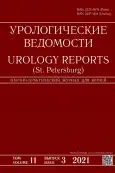Нужна ли неоадъювантная химиотерапия при хирургическом лечении туберкулеза почек?
- Авторы: Холтобин Д.П.1,2, Кульчавеня Е.В.1,3
-
Учреждения:
- Новосибирский научно-исследовательский институт туберкулеза
- Медицинский центр «Авиценна»
- Новосибирский государственный медицинский университет
- Выпуск: Том 11, № 3 (2021)
- Страницы: 263-270
- Раздел: Клинические наблюдения
- Статья получена: 22.08.2021
- Статья одобрена: 19.09.2021
- Статья опубликована: 11.10.2021
- URL: https://journals.eco-vector.com/uroved/article/view/78688
- DOI: https://doi.org/10.17816/uroved78688
- ID: 78688
Цитировать
Аннотация
Актуальность урогенитального туберкулеза остается высокой, равно как его социальная значимость. С появлением противотуберкулезных препаратов появилась возможность выполнения органосохраняющих операций, однако крайне важным является противотуберкулезная химиотерапия — как в предоперационном периоде, так и после хирургического вмешательства. Нарушение этого принципа приводит к развитию тяжелых осложнений, что демонстрирует клиническое наблюдение. Пациентка И., 40 лет. Диагноз: «Поликавернозный туберкулез правой почки, кавернозный туберкулез левой почки, туберкулез мочевого пузыря 4-й стадии (микроцистис)». Противотуберкулезные препараты принимала нерегулярно и бессистемно. На этом фоне в урологическом отделении общего профиля выполнена лапароскопическая нефрэктомия справа, наложена пункционная нефростома слева. Терапия противотуберкулезными препаратами прекращена, что привело к прогрессированию почечной недостаточности и очередным атакам пиелонефрита. В связи с этим повторно оперирована в МЦ «Авиценна»: лапароскопическая кавернотомия единственной левой почки, цистэктомия, энтероцистопластика по Штудеру. В послеоперационном периоде сформировался резервуарно-маточный свищ. Противотуберкулезное лечение не получала. Пациентка вновь обратилась в МЦ «Авиценна» через 9 мес., было выполнено лапароскопическое удаление сморщенного кишечного резервуара с формированием уретероилеостомы по Брикеру с хорошим ближайшим и отдаленным (срок наблюдения 10 мес.) результатом.
Полный текст
Об авторах
Денис Петрович Холтобин
Новосибирский научно-исследовательский институт туберкулеза; Медицинский центр «Авиценна»
Email: urology-avicenna@mail.ru
ORCID iD: 0000-0001-6645-6455
SPIN-код: 5473-4282
Scopus Author ID: 54889009300
канд. мед. наук, врач-уролог
Россия, 630040, Новосибирск, ул. Охотская, д. 81А; НовосибирскЕкатерина Валерьевна Кульчавеня
Новосибирский научно-исследовательский институт туберкулеза; Новосибирский государственный медицинский университет
Автор, ответственный за переписку.
Email: urotub@yandex.ru
ORCID iD: 0000-0001-8062-7775
SPIN-код: 5244-4960
Scopus Author ID: 6505712683
д-р мед. наук, профессор
Россия, 630040, Новосибирск, ул. Охотская, д. 81А; НовосибирскСписок литературы
- World Health Organisation. The Top 10 Causes of Death, 2018. Режим доступа: https://www.who.int/news-room/fact-sheets/detail/the-top-10-causes-of-death. Дата обращения: 20.09.2021.
- World Health Organisation. Tuberculosis. Key Facts, 2019. Режим доступа: https://www.who.int/news-room/fact-sheets/detail/tuberculosis. Дата обращения: 20.09.2021.
- Pai M., Memish Z.A. Global tuberculosis control requires greater ambition and resources // J Epidemiol Glob Health. 2015. Vol. 5, No. 1. P. 1–2. doi: 10.1016/j.jegh.2015.01.001
- Щербань М.Н., Кульчавеня Е.В., Брижатюк Е.В. Диагностика, предупреждение и лечение нарушений репродуктивной функции у мужчин // Туберкулез и болезни легких. 2010. Т. 87, № 10. С. 31–36.
- Khanna A., Agrawal A. Markers of genital tuberculosis in infertility // Singapore Med J. 2011. Vol. 52, No. 12. P. 864–867.
- Shahzad S. Investigation of the prevalence of female genital tract tuberculosis and its relation to female infertility: An observational analytical study // Iran J Reprod Med. 2012. Vol. 10, No. 6. P. 581–588.
- Gupta R.K., Lucas S.B., Fielding K.L., Lawn S.D. Prevalence of tuberculosis in post-mortem studies of HIV-infected adults and children in resource-limited settings: a systematic review and meta-analysis // AIDS. 2015. Vol. 29, No. 15. P. 1987–2002. doi: 10.1097/QAD.0000000000000802
- Global tuberculosis report 2019. WHO/CDS/TB/2019.15. Режим доступа: https://apps.who.int/iris/bitstream/handle/10665/329368 /9789241565714-eng.pdf?ua=1. Дата обращения: 20.09.2021.
- MacNeil A., Glaziou P., Sismanidis C., et al. Global Epidemiology of Tuberculosis and Progress Toward Achieving Global Targets – 2017 // MMWR Morb Mortal Wkly Rep. 2019. Vol. 68, No. 11. P. 263–266. doi: 10.15585/mmwr.mm6811a3
- Furin J., Cox H., Pai M. Tuberculosis // Lancet. 2019. Vol. 393, No. 10181. P. 1642–1656. doi: 10.1016/S0140-6736(19)30308-3
- Кульчавеня Е.В., Жукова И.И. Внелегочный туберкулез — вопросов больше, чем ответов // Туберкулез и болезни легких. 2017. Т. 95, № 2. С. 59–63 doi: 10.21292/2075-1230-2017-95-2-59-63
- Kulchavenya E, Kholtobin D, Shevchenko S. Challenges in urogenital tuberculosis // World J Urol. 2020. Vol. 38, No. 1. P. 89–94. doi: 10.1007/s00345-019-02767-x
- Ткачук В.Н., Ягафарова Р.К., Аль-Шукри С.Х. Туберкулез мочеполовой системы: Руководство. СПб.: СпецЛит, 2004. 319 с.
- Adhikari S., Basnyat B. Extrapulmonary tuberculosis: a debilitating and often neglected public health problem // BMJ Case Rep. 2018. Vol. 11, No. 1. P. e226098. doi: 10.1136/bcr-2018-226098
- Muneer A., Macrae B., Krishnamoorthy S., Zumla A. Urogenital tuberculosis – epidemiology, pathogenesis and clinical features // Nat Rev Urol. 2019. Vol. 16, No. 10. P. 573–598. doi: 10.1038/s41585-019-0228-9
- Kulchavenya E., Naber K., Bjerklund Johansen T.E. Urogenital tuberculosis: classification, diagnosis, and treatment // Eur Urol Suppl. 2016. Vol. 15, No. 4. P. 112–121. doi: 10.1016/j.eursup.2016.04.001
- Kocjancic E., Sedlar A. Tuberculous cystitis // Curr Bladder Dysfunct Rep. 2012. Vol. 7. P. 105–112. doi: 10.1007/s11884-012-0128-9
- Quddus M.A., Uddin M.J., Bhuiyan M.M. Evaluation of extra pulmonary tuberculosis in Bangladeshi patients // Mymensingh Med J. 2014. Vol. 23, No. 4. P. 758–763.
- Shekar P.A., Kumar P.S. Microbiological diagnosis in urogenital tuberculosis: the Holy Grail still Eludes // World J Urol. 2020. doi: 10.1007/s00345-020-03293-x
- Lee J.Y. Diagnosis and treatment of extrapulmonary tuberculosis // Tuberc Respir Dis (Seoul). 2015. Vol. 78, No. 2. P. 47–55 doi: 10.4046/trd.2015.78.2.47
- Moll F.H., Halling T., Griemmert M. Seuchengeschichte in der deutschsprachigen Urologie // Urologe A. 2020. Vol. 59, No. 8. P. 941–952. (In German.) doi: 10.1007/s00120-020-01253-2
- Tang Y.S., Li S.Y., Tarng D.C. Mulberry-Like Calcification Occupying Left Kidney // Am J Med Sci. 2020. Vol. 360, No. 4. P. e4. doi: 10.1016/j.amjms.2020.05.002
- Грунд В.Д. Ошибки в диагностике и лечении туберкулеза мочеполовой системы. М.: Медицина, 1975.
Дополнительные файлы











